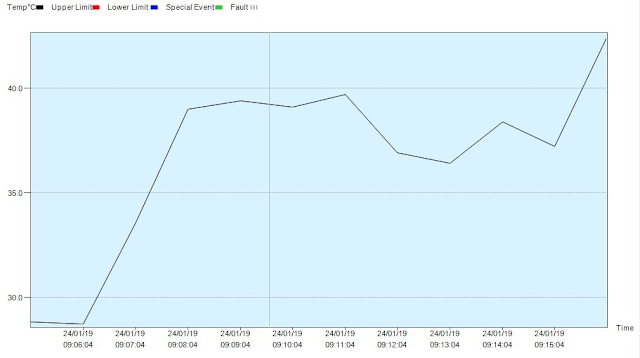So, it happened again...
My nose identified the smell of burning insulation and electrolyte, and I noted some smoke emerging from "down there".
I quickly pulled off the road (smoke being spread by the fan) shut off the ignition, pulled the tool kit and disconnected the battery.
This left me on the side of the road, so I pushed it down a lane a little ways (to keep it from attracting the wrong kind of attention), hitch hiked home (I was on the way home), got my truck and came back with a new part and tools.
It requires a bit of jiggery to organise me getting back both vehicles.
Readers of my blog will know of my previous issue (documented here) and my conjecture of would it survive the hottest days ... I'm pretty sure I know the answer now ;-)
As I wrote back then when I fitted the fan unit:
I was riding around and thinking about how close that graph got to 50C and thought that since the air temperature right now is like 20C (middle of the day) and that in summer its going to be nearly 50C (coming directly off the road) that will drive that temperature up closer to limits again. So I decided to look for power and attach a small case fan to assist cooling.
So as I suspected on at +34C day it didn't get sufficient cooling.
I decided that I needed to do new testing (because it was still bloody hot) and so I thought test it with
- cover on (fan cooled only)
- cover off (fan still there)
To test I embedded a sensor between fins to avoid air cooling of the sensor (and get the temperature of the heatsink) like this:
*(Note: the new cheapo part is no longer black, which is stupid)
The "cover off ride looks like this
with good exposure to air for the cooling. The temperature plot (which included a length of highway at 100km/h)
I then slipped the cover on
and went back out, getting this reading
you'll note that it got to 60 pretty soon and flattened (I was keeping an eye on the meter readout) and rose briefly when I was back in town (presumably due to lower air flows.Semiconductor parts are most often specified for use in the “commercial” 0 to 70°C and, to a lesser extent, in the “industrial” -40 to 85°C operating temperature range. These operating temperature ratings generally satisfy the demands of the dominant semiconductor customers in the computer, telecommunications, and consumer electronic industries.





















1 comment:
not much of an expert here, but would it be possible to mount the regulator/rectifier somewhere outside the cover? let's say somewhere close to the passenger pegs location to get max airflow?
Post a Comment